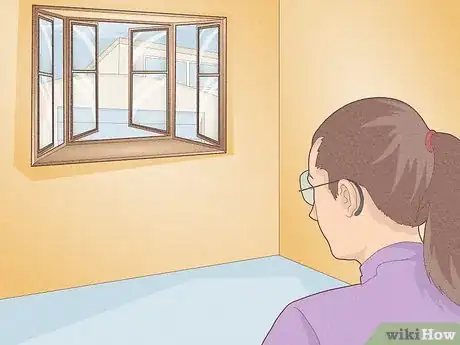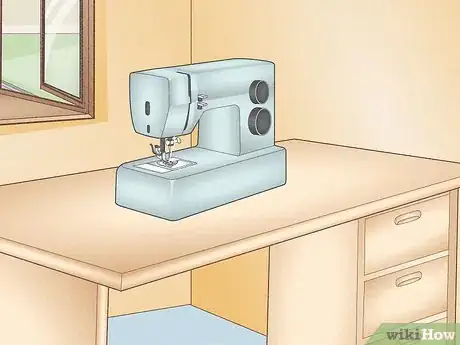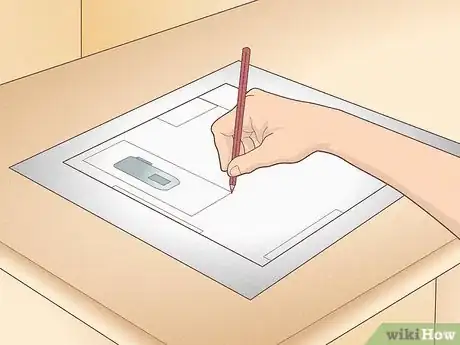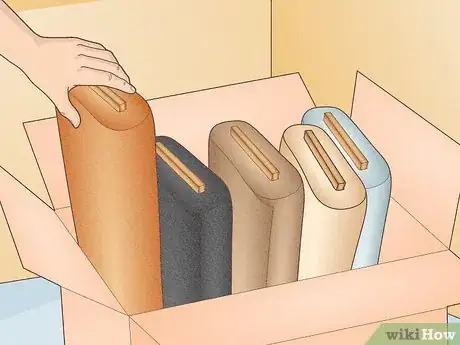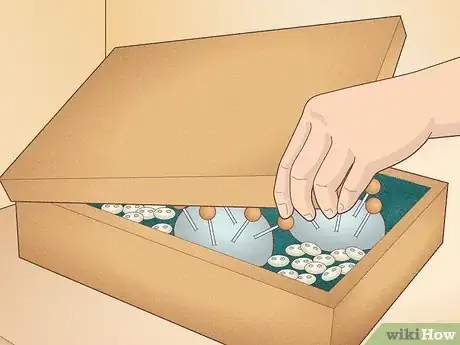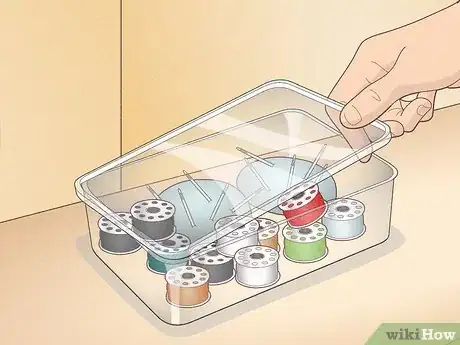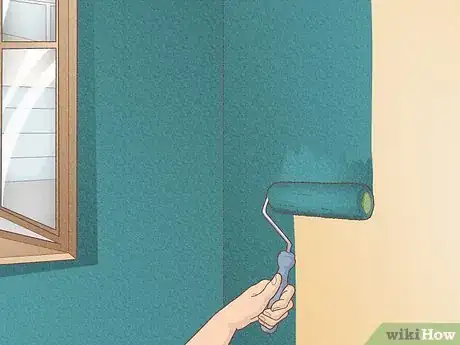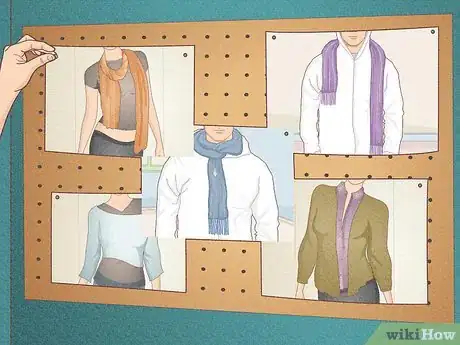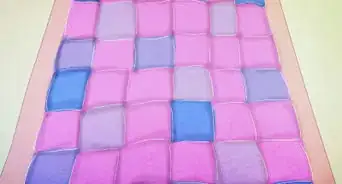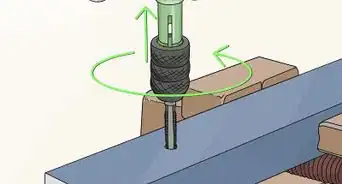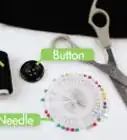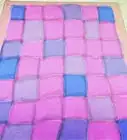This article was co-authored by Alessio Iadicicco. Alessio Iadicicco is an Apparel Manufacturing Specialist and the CEO and Co-Founder of MarkersValley, an online apparel and manufacturer sourcing platform that connects luxury fashion brands to a network of highly-vetted, truly Italian manufacturers. He holds a Bachelor's degree in Economy and Management of Financial Enterprises from The University of Naples Federico II. MarkersValley has connected fashion brands in over 100 countries and has a network of over 100 independent Italian factories and artisans. MarkersValley has been featured in Forbes, EQ, St. Louis Business Journal, Il Mattino, and Corriere Della Sera.
There are 12 references cited in this article, which can be found at the bottom of the page.
This article has been viewed 120,726 times.
If you're a tailor or seamstress, having a designated sewing room can be a great place to sew in peace, store your equipment, or get inspiration for projects. While sewing rooms can be highly individualized, good sewing rooms are well organized. This requires giving some thought to your needs, your space, and your storage.
Steps
Arranging the Room
-
1Decide what room you are going to use. Offices or spare bedrooms are perfect for turning into sewing rooms. While it doesn't have to be large, make sure the space is at least enough for a storage area and a sewing table or desk.
- If you do not have an entire room to devote to sewing, set aside an area in a room that is used for other things. A bedroom, office, family room, den, or even a closet could have a sewing space in it.
- If sharing space within another room, determine if you want to keep it open or divide the space for separate uses.
- Make sure whatever space you choose has easy access to electrical outlets for your equipment, lamps, or computer.[1]
-
2Determine what equipment and furniture you want to place in your sewing room. An old computer desk will work perfectly for a sewing table. You can also use a chest of drawers for storage. Consider what large items you want in the room, such as an ironing board or couch.
- If you'd like to include a cutting table, it needs to be accessible from multiple sides and be large enough to fit the fabric for whatever projects you'll be working on. You should also make sure the table is high enough for you to stand without back pain.[2]
- If you have a small space, try to use things that will double up your storage. For example, you can set your sewing machine on a desk and use the drawers for storage.
- Don't forget to include a way to store trash, recycle, and project scraps.
Advertisement -
3Draw the floor plan of the room or area. Include your equipment and items from step 2. These could be things like a desk for your sewing machine, cutting table, small couch, ironing board, storage, and shelves.
- Remember to include bookcases or wall-mounted shelves. Closet companies can help install custom storage, or you can buy closet organizer kits and install them yourself.
- Make a cutting area, sewing area, and pressing area. Place these areas in a work triangle to maximize efficiency when moving around the room.[3]
- If you have a large room, placing your workstation in the center of the room allows you to work on all sides.
-
4Arrange the equipment and furniture according to your floor plan. Start with any built-in storage, then add the desk or sewing table, and any portable storage.
- Keep electricity outlets in mind when setting up machinery and lamps. Make sure you won't have to use electrical cords, which could be tripping hazards.[4] If you use power strips, use a surge protector to prevent any damage to your machinery.
- Make sure the room has good general light. This could come from windows. You'll also need lots of localized light for projects. You'll require several task-specific lamps that allow you to direct light.
Organizing Your Materials
-
1Begin by sorting and arranging your largest items. These could include bolts of fabric, an ironing board, or a full-length mirror. Make sure things that you frequently use are easy to access, while tools you only occasionally use are well stored and labeled so that you can find them.
- Ironing board caddies that hang on the door are a great way to save space in a smaller sewing room.
- A large mirror can be placed on the back of a door if you can't fit a full-length mirror in the room.
- Care should be taken when storing fabric. Make sure it's out of direct sunlight, as prolonged exposure could cause it to fade. Fabric can be hung, stored folded on shelves, rolled and stored in boxes, or filed in a cabinet.[5]
-
2Determine what materials you'd like to conceal while storing. These could be tools you don't use frequently or you'd simply like to store out of sight. For example, you might have a bunch of small notions that you occasionally use, but want to store. You might consider placing them all in the compartments of a toolbox, then keep the toolbox in a closet.
- Closets are one of the best ways to store materials. The shelves are good for storing bolts of fabric, or boxes of equipment and scraps. You can also hang fabric from the clothing rod in the closet.[6]
- Pull-out storage keeps items hidden, but easy to access. Consider using a pull-out shelf in a cabinet or desk.[7]
- A file cabinet is useful for keeping patterns organized.[8] If you don't want to see a file cabinet in your room, you can always place it in the closet and store items on top of it, for added storage.
-
3Choose what materials you'd like to store in the open. A benefit of this is that you'll quickly be able to find these items. Clear storage is a good way to store bobbins, needles, measuring tape, and pins.
- Some of the materials you'll need to keep close at hand include a measuring tape, scissors, chalk, thimble, pins, a seam ripper, basting thread, machine needles, and hand sewing needles.[9]
- If you're worried about your space looking cluttered, make sure the items are organized by type, but displayed similarly. For instance, arranging all your buttons, regardless of color, in several similar clear jars quickly shows you what colors you have while keeping them uniform.
- Pegboard is also a good option for visibly displaying and storing frequently used materials. Rods can be attached to display spools of ribbon or thread. Pegboard is a good alternative to drawer storage when it comes to ease of use.
Decorating the Room
-
1Paint or wallpaper the room. Keep in mind that cool colors (blues, greens, purples) have a calming effect while warm colors (reds, pinks, oranges) excite.
- Consider what mood you want to evoke in your room. For example, if you want a relaxing room, consider using green. Yellow-orange creates an inviting atmosphere. To help you focus on projects, consider blue-green. Red-orange can encourage creativity.[10]
- Keep lighting in mind when choosing colors for the walls. If your room doesn't have much natural light, you might not want to choose a darker color. Lighter colors can make the room feel brighter and larger.[11]
- If you don't want to paint or wallpaper the room, but would still like to change the color, you can display quilts, hang curtains, or paint shelving units in your chosen color.
-
2Add soft furnishings to the space. Make sure your room is comfortable so you'll enjoy using it. Cushions, pillows, and soft throws can make the room cozier and more inviting. This is also a great way to add color and display soft furnishings you've made.
- Soft furnishings have practical uses. Rugs are great for adding comfort to hard flooring and absorbing noise. Pillows and cushions can make your chairs or couch more comfortable.[12] A cushioned chair on wheels can also prevent back pain when working long hours at your workspace.[13]
- If you'd like to redecorate your sewing room as the seasons change, swap out rugs, cushions, or curtains for a quick and inexpensive room update.[14]
- Think vertically when personalizing your room. A large wall is a great place to hang a finished quilt. Bookshelves are handy places to store blankets or cushions for easy use while displaying pops of color.
-
3Showcase your work and what inspires you. Have an inspiration board or wall where you can hang project ideas. These could be magazine clippings, scraps of fabric, paint chips, or anything that motivates you.
- Popular inspiration boards can be made of cork, covered with coordinating fabric, or magnetized.[15]
- Place crafting magazines, books, and patterns on shelves where you can quickly get ideas. Have comfy seating nearby so you can relax and consider new projects.
- You can also make a space to display completed projects or sewing collections. Arrange them on floating shelves or frames and hang them around the room. To display small items, such as bobbins or thimbles, arrange them individually in a typesetter's tray.
Community Q&A
-
QuestionHow tall should a sewing table be?
 Community AnswerThe table should be tall enough that you can sit up straight and hold your arms at a comfortable angle whether resting on the table or held slightly above, much like a good desk.
Community AnswerThe table should be tall enough that you can sit up straight and hold your arms at a comfortable angle whether resting on the table or held slightly above, much like a good desk. -
QuestionHow should I arrange my sewing room?
 Community AnswerYou need a good work table that is close to an outlet (so you can plug in your sewing machine). Have storage for fabric, materials, finished projects. Have an easy access display of your most used threads, extra bobbins, scissors, elastics, needles, and what not. Secure a measuring tape to the edge of your work table so you can hold your fabric up to the tape measure for easy measuring. Have good lighting in your sewing room and a table just for cutting fabric/assembling patterns is useful but not necessary.
Community AnswerYou need a good work table that is close to an outlet (so you can plug in your sewing machine). Have storage for fabric, materials, finished projects. Have an easy access display of your most used threads, extra bobbins, scissors, elastics, needles, and what not. Secure a measuring tape to the edge of your work table so you can hold your fabric up to the tape measure for easy measuring. Have good lighting in your sewing room and a table just for cutting fabric/assembling patterns is useful but not necessary.
References
- ↑ http://www.sewing.org/files/guidelines/2_101_setting_up_a_sewing_room.pdf
- ↑ http://www.sewing.org/files/guidelines/2_101_setting_up_a_sewing_room.pdf
- ↑ http://sewing.lifetips.com//cat/57601/sewing-room/index.html
- ↑ http://www.sewing.org/files/guidelines/2_101_setting_up_a_sewing_room.pdf
- ↑ http://www.allpeoplequilt.com/how-to-quilt/organization/storage-solutions
- ↑ http://organizedhome.com/sew-organized/storage-tips-for-sewing-areas
- ↑ http://www.thisoldhouse.com/toh/how-to/intro/0,,709890,00.html
- ↑ http://www.craftsy.com/blog/2013/03/sewing-room-ideas/
- ↑ Alessio Iadicicco. Apparel Manufacturing Specialist. Expert Interview. 20 May 2021.
- ↑ http://www.hgtv.com/color/create-a-mood-with-color/pictures/index.html
- ↑ http://www.lowes.com/projects/other-activities/make-small-room-look-larger/project
- ↑ http://www.homeadvisorhomesource.com/benefits-of-using-soft-furnishing/
- ↑ http://sewing.lifetips.com//cat/57601/sewing-room/index.html
- ↑ http://www.womansday.com/home/decorating-ideas/make-your-home-a-comfort-zone-107402#slide-1
- ↑ http://www.favecrafts.com/Sewing/16-Sewing-Room-Design-Ideas
- ↑ http://www.craftsy.com/blog/2013/03/sewing-room-ideas/
About This Article
To set up a sewing room, start by getting a desk or table so you have a surface to sew on. Then, get some storage bins or a chest with drawers so you have somewhere to keep all of your sewing supplies. For even more storage, include bookcases or wall-mounted shelves. You'll also want to include room for an ironing board, a cutting table, and receptacles for trash, recycling, and project scraps. When you design the layout of your room, keep electrical outlets in mind so you don't have extension cords running everywhere. To learn how to decorate a sewing room, scroll down!
